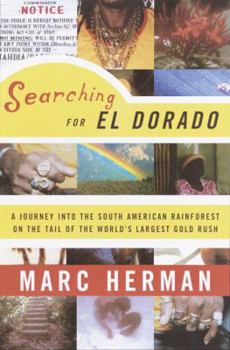Searching for El Dorado: A Journey Into the South American Rainforest on the Tail of the World's Largest Gold Rush
Select Format
Select Condition 
Book Overview
The search for the lost City of Gold in the Amazon basin has inspired adventurers since the days of the Spanish conquistadors and Sir Walter Raleigh. Intrigued by the cultural, economic, and... This description may be from another edition of this product.
Format:Hardcover
Language:English
ISBN:0385502524
ISBN13:9780385502528
Release Date:February 2003
Publisher:Nan A. Talese
Length:253 Pages
Weight:0.95 lbs.
Dimensions:0.9" x 6.0" x 8.6"
Related Subjects
Action & Adventure Adventure Americas Education & Reference Fiction Folklore & Mythology General Genre Fiction History Literature & Fiction Natural Resources Nature Nature & Ecology Politics & Social Sciences Reference Social Science Social Sciences South America Specialty Travel Travel Travel Writing VenezuelaCustomer Reviews
4 ratings
Fascinating portrait of a little-known country and of the gold-mining industry
Published by Thriftbooks.com User , 17 years ago
_Searching for El Dorado_ by Marc Herman is an intriguing look at a land of contrasts, the South American nation of Guyana. Though the nation has potentially billions of dollars of untapped gold and a large percentage of its citizens are employed in the gold-mining industry, it is one of the very poorest nations in the western hemisphere. The various ways in which gold is mined are all destructive and dangerous yet the consequences of stopping the mines could possibly be even worse. There are two main ways in which gold is produced. One way is used by large foreign-owned internationally-financed mining corporations, mines which employ professional geologists and millions of dollars in heavy equipment. The other is used by small-time local miners, sometimes working in small groups, often independently. These are subsistence operations and are run with only a few crude tools, often by uneducated if not illiterate men. Local miners can produce gold from the creeks and rivers. River-mining uses slow rafts that float low in the water, made of scrap metal and of questionable seaworthiness. Located on the center of these rafts is an engine and pump, connected to a hose that goes over the side. A diver (breathing through a small rubber hose gripped in his teeth) takes the hose to the riverbed, dredges the bottom, and the other miners (usually there are about five or six) collect the riverbed mud, which is treated with mercury, which bonds with the gold in the sediment and forms heavy nuggets which drop out of solution in the mud. The mud is strained to remove these nuggets and the rest of the mud is dumped back into the river. Land mines are created when miners cut down a patch of trees and dig holes ten or twenty feet across in the forest floor. Men would then enter the clearing and wet down the bottom and the sides of the hole with water from buckets or high-pressure hoses (the water drawn from a nearby river or swamp). Other miners would haul out the mud and place it in a long box where it would be treated with mercury. With either method, once the nuggets were obtained the miners would use a blowtorch on them. Most of the mercury would boil and rise as vapor though some could be saved, often collected in a rag which was later wrung out. What would be left would be small amounts of gold, often just a few ounces resulting from tons of mud being collected. The small-time miners had it hard. The work was very physically demanding. There were no police (indeed, the mining was often illegal) and the miners had to keep their gold on them in the form of cheap, badly made jewelry or gold teeth. Miners were occasionally robbed or more often forced by other miners off of particularly rich patches. They would also have to compete with miners from other countries, such as Venezuela or Brazil (border control being almost nonexistent in the jungle) or being preyed upon by corrupt police (more often a problem in Venezuela than Guyana). The mercury was
A great read!
Published by Thriftbooks.com User , 21 years ago
I was puzzled when my friend gave me a copy of this book; had I ever expressed an interest in gold or indeed in South America? The mystery was solved when my gaze rested on the author's name, an old university friend. Not knowing much about Marc's politics or his writing style, I was a afraid that the book would be some tirade against big business and globalization. Refreshingly, I discovered an engaging search for answers in a country that seems to only have questions. The book is interesting, provocative, and well-balanced journalism. But even better then that is Marc's humorous description of his own journey, his adventures, and his eye for details. I am not sure I reccomend traveling "Marc-style" but I sure do enjoy the product of his adventures!
Fantastic accounts of his encounters
Published by Thriftbooks.com User , 21 years ago
Fantastic (and very accurate) accounts of his encounters with the local folk and descriptions of the places he passed through on his journey. Made for a racey, entertaining and somewhat exotic read. Alot of first hand information for anyone thinking of travelling through Guyana indeed!
So funny, so smart
Published by Thriftbooks.com User , 21 years ago
I want Marc Herman to be my travel guide, whenever I sit back in my armchair -- or whenever I enter a new land. His easygoing style is seductive, but the energy of his insight into the culture is what makes him so appealing.How can a country so full of gold have so many problems? Journey with Marc and find out; and have a blast along the way.





